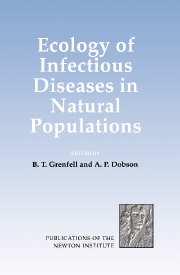Book contents
- Frontmatter
- Contents
- List of Participants
- Introduction
- BROAD PATTERNS AND PROCESSES
- PATHOGENS, INSECTS AND PLANTS
- IMPACT OF ECOLOGICAL AND GENETIC HETEROGENEITY
- Environmental Influences on Host Immunity
- Modelling the Immuno-Epidemiology of Macroparasites in Wildlife Host Populations
- Spatial Dynamics of Parasitism
- Spatial Dynamics Group Report
- Genetic Diversity in Host-Parasite Interactions
- Genetics and Evolution of Infectious Diseases in Natural Populations Group Report
- Beyond Host-Pathogen Dynamics
- Glossary
Genetic Diversity in Host-Parasite Interactions
Published online by Cambridge University Press: 22 January 2010
- Frontmatter
- Contents
- List of Participants
- Introduction
- BROAD PATTERNS AND PROCESSES
- PATHOGENS, INSECTS AND PLANTS
- IMPACT OF ECOLOGICAL AND GENETIC HETEROGENEITY
- Environmental Influences on Host Immunity
- Modelling the Immuno-Epidemiology of Macroparasites in Wildlife Host Populations
- Spatial Dynamics of Parasitism
- Spatial Dynamics Group Report
- Genetic Diversity in Host-Parasite Interactions
- Genetics and Evolution of Infectious Diseases in Natural Populations Group Report
- Beyond Host-Pathogen Dynamics
- Glossary
Summary
Introduction
Probably a very small biochemical change will give a host species a substantial degree of resistance to a highly adapted microorganism. This has an important evolutionary effect. It means that it is an advantage to the individual to possess a rare biochemical phenotype. For just because of its rarity it will be resistant to diseases which attack the majority of its fellows.
(Haldane 1949)As is clear from this passage, Haldane recognized that the temporary resistance conferred by rarity could lead to the maintenance of alleles involved in antagonistic coevolution. He then set out to explain the ‘surprising diversity revealed by serological tests,’ and suggested that some of the proteins uncovered in these tests ‘may play a part in disease resistance.’
Our purpose here is to review some of the more important theoretical and empirical advances since Haldane's time. We begin by considering simple genetic models of host-parasite interactions, with a particular interest in whether such interactions are expected to result in (1) stable equilibria for allele frequencies, (2) stable limit cycles of small amplitude, (3) stable limit cycles of large amplitude, or (4) unstable oscillations (see Fig. 1). We suggest that unstable oscillations, as well as stable oscillations having large amplitudes, can lead to the loss of genetic diversity, and discuss ways in which diversity could be protected, or at least re-supplied, if lost.
We then extend the discussion to consider the polygenic basis of resistance, and discuss the molecular evidence for the accrual of resistance genes in vertebrate genomes. It is clear that a profound revolution has taken place in our understanding of the genetic basis of disease resistance.
- Type
- Chapter
- Information
- Ecology of Infectious Diseases in Natural Populations , pp. 421 - 449Publisher: Cambridge University PressPrint publication year: 1995
- 21
- Cited by



